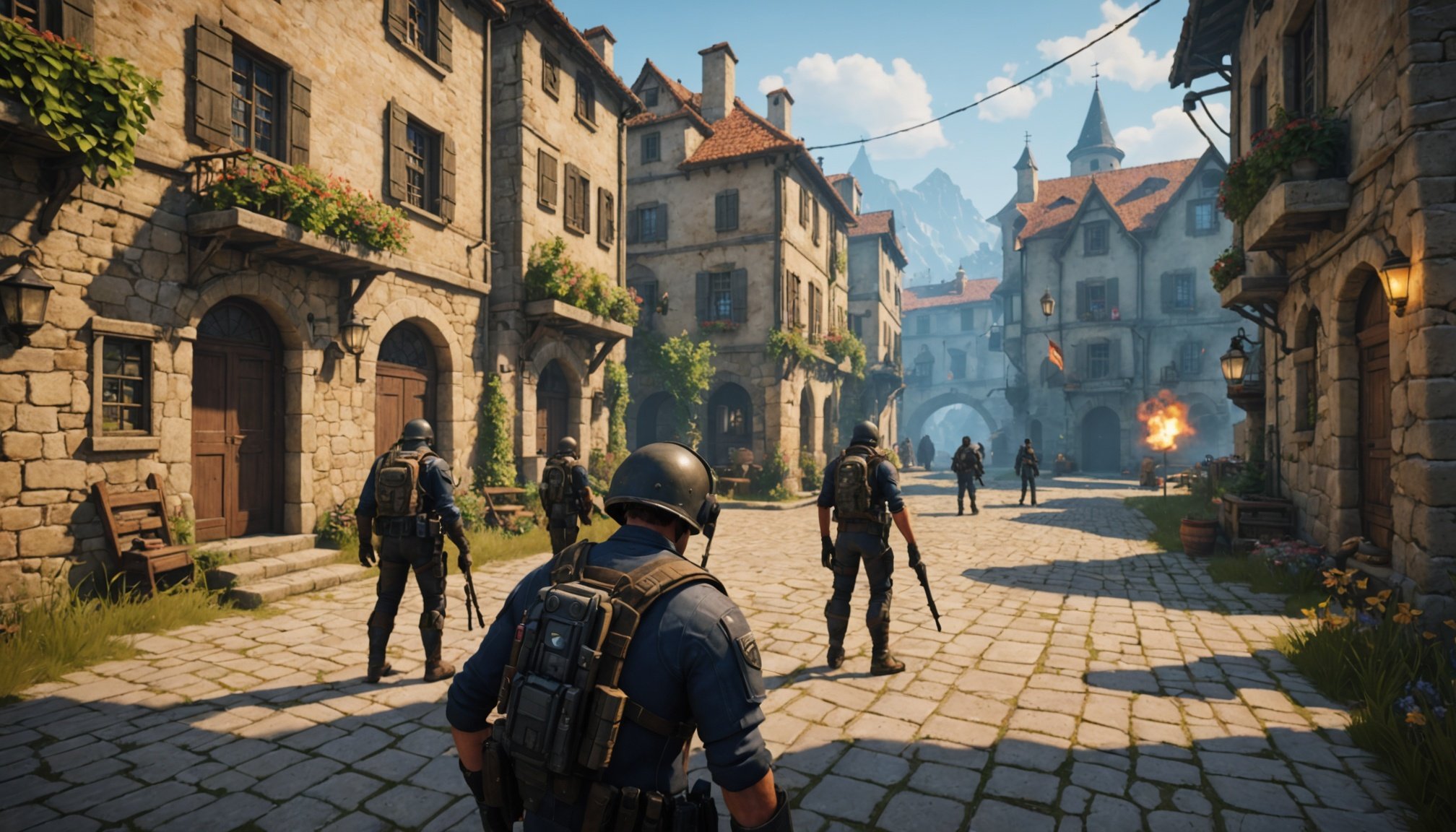Importance of Communication in Online Multiplayer Games
In the realm of online multiplayer games, effective communication plays a critical role in shaping both team dynamics and game outcomes. Every multiplayer gamer understands that efficiently executed teamwork often spells the difference between victory and defeat. Communication isn’t just about passing information; it’s about crafting a strategy that exploits each player’s strengths, significantly boosting game performance.
For instance, in games like League of Legends or Call of Duty, successful communication can coordinate complex strategies, effectively ambush opponents, or efficiently manage team resources. Teams that excel in communication often attribute their success to clear roles and reliable communication protocols.
Topic to read : Exploring exciting career opportunities in the gaming industry: what’s your path?
Conversely, poor communication can lead to disastrous in-game consequences. Misunderstandings might cause mistimed attacks or misallocated resources that severely impair a team’s capability to compete effectively. In some cases, it can even create tension or conflict within the team, ultimately affecting morale and performance.
Understanding the importance of communication is crucial for any gamer looking to enhance their skills. It’s more than talking; it’s about connecting, planning, and executing as a cohesive unit. Consequently, developing communication skills can propel a player’s gaming experience from average to exceptional.
Also read : Crafting an impressive game designer portfolio: a step-by-step guide
Effective Communication Techniques
In the fast-paced world of online gaming, mastering specific communication techniques is crucial for executing effective player strategies. Utilising both vocal and text communication methods can significantly enhance gameplay.
Utilizing Voice Chat
Voice chat offers gamers the means for clear and concise verbal exchanges, essential for on-the-fly decision making. Best practices include avoiding background noise and using headsets for clarity. In game scenarios, coordinating player strategies via voice chat enables rapid response to threats and dynamic tactical shifts.
Text Communication Strategies
Text chat shouldn’t be dismissed as a slower alternative. The importance of textual clarity aids in maintaining records of communication for quick references. Utilizing in-game chat features can be pivotal during intense gaming sessions. Mastering shorthand and abbreviations, such as “OOM” for out-of-mana, speeds up message delivery while maintaining efficiency.
Non-Verbal Communication Signals
Even without words, games are replete with non-verbal communication signals. Understanding in-game character gestures and the significance of pings and visual markers can inform players of key developments. Coordinating through these cues provides an additional layer of strategy, maintaining fluid communication without verbal interruptions. This holistic approach to communication techniques optimises player interactions in both simple and complex gaming scenarios.
Tools and Resources for Enhanced Communication
In the realm of online multiplayer gaming, leveraging effective communication tools is essential for seamless team coordination. Players often rely on software like Discord and TeamSpeak, which have become synonymous with team communication due to their intuitive interfaces and reliable service. These platforms provide real-time voice chat, enhancing the immediacy and clarity of player interactions.
Many games also offer built-in communication tools, such as in-game voice and text chats, enabling on-the-fly strategizing without the need for external software. However, these may not always provide the comprehensive features found in standalone applications. External communication apps are preferred for expanding communication capabilities beyond in-game limitations, offering advantages like customized chat rooms and enhanced audio quality.
The benefits of integrating such communication tools are manifold. They facilitate better strategic planning, foster stronger team cohesion, and enable faster responses during tense gaming moments. Additionally, they support asynchronous communication, allowing team members to share plans and updates even outside gaming sessions.
By combining these resources, gamers can optimize their team coordination, ensuring every member is aligned and prepared for competitive play. This approach enhances both the individual gaming experience and overall team synergy.
Common Pitfalls in Team Communication
Communication is vital for successful gameplay, but several pitfalls can hinder team dynamics. These obstacles can lead to misunderstandings, conflicts, and negatively impact game outcomes.
Identifying Miscommunication
Miscommunication often arises in chaotic gaming situations where rapid exchanges of information are critical. Confusion might occur when players misinterpret strategic instructions, leading to mistimed attacks or ineffective defenses. Recognising these scenarios enables quick correction, improving game performance and maintaining effective teamwork.
Handling Conflicts and Disagreements
In high-stakes games, conflicts among team members can arise. Effectively resolving these disagreements requires techniques to maintain a positive environment. Encourage open discussions and mutual respect, enabling players to communicate efficiently under stress. This ensures smooth team coordination and a unified approach.
Recognizing and Addressing Toxic Behavior
Toxic behavior, such as bullying or harassment, sabotages team morale and trust. Recognising signs of toxic communication, like aggression or exclusion, is crucial. Employ strategies to counteract negativity, fostering a supportive and inclusive culture. Reporting such behavior when necessary ensures everyone can contribute their strengths, harnessing a harmonious team spirit.
Measuring Communication Effectiveness
Evaluating communication effectiveness in online multiplayer games is crucial for enhancing team performance. But how can teams measure this aspect accurately? The answer lies in structured feedback loops and other methods of assessment.
One common approach is holding regular feedback sessions. These sessions allow team members to discuss what communication strategies worked and what did not. Such open dialogue can highlight strengths, address weaknesses, and promote continuous improvement. In addition, these discussions often boost team cohesion by encouraging trust-building and transparency among players.
Different tools can also play a significant role in analyzing communication during gameplay. For example, recording and reviewing game sessions can reveal patterns in team interactions, making it easier to identify areas needing improvement. These insights can be instrumental in crafting targeted communication strategies to bolster efficiency.
Furthermore, exploring metrics like response time to messages or the clarity and execution of shared strategies can provide tangible measures of a team’s communication prowess. These metrics not only reveal current performance levels but also guide future training and development.
Ultimately, continuous assessment and adaptation will ensure communication remains effective, leading teams toward better coordination and more successful outcomes in the gaming environment.
Building Team Cohesion and Trust
Fostering team cohesion and building trust among players in online multiplayer games are pivotal for achieving superior gameplay. Trust forms the foundation upon which effective player relationships are built, significantly influencing team dynamics and performance.
Methods to Promote Trust
Promoting trust begins with creating an atmosphere where open communication is encouraged. Teams can develop trust by clearly defining roles and acknowledging each player’s contributions. Team-building activities, conducted both within and outside of games, reinforce these structures by facilitating bonding and understanding.
Recognising trust-building as an ongoing process within and outside gaming sessions strengthens relationships and enhances coordination.
Influence of Positive Relationships
Positive player relationships elevate teamwork by ensuring members are more likely to support one another. This camaraderie leads to smoother collaborations and faster problem resolution when challenges arise. Sustained cohesion translates into improved strategy execution and effective resource management, contributing to the overall team performance.
By investing in trust-building and nurturing a supportive environment, teams can unlock their full potential, driving successful outcomes and enriching the gaming experience. Strong bonds among players not only facilitate current objectives but also lay a foundation for long-term success in future challenges.
The Impact of Technology on Communication
Technology significantly influences how teams communicate in online multiplayer games. Current trends in gaming technology are reshaping player interactions, offering advanced tools that enhance communication.
AI and Gaming Interactions
Artificial Intelligence (AI) stands at the forefront of these advancements, providing players with enhanced interaction capabilities. AI can facilitate smoother gaming experiences by anticipating and resolving communication gaps before they affect team strategies. For example, AI-driven virtual assistants can manage routine tasks, alerting teams to strategic shifts or new challenges quickly and efficiently.
Future Communication Trends
Looking ahead, future trends suggest an even greater integration of communication technologies in multiplayer environments. Developments like real-time language translation tools could dissolve language barriers, allowing teams worldwide to perform seamlessly. These tools could amplify teams’ strategic potential, boosting their game performance.
Incorporating cutting-edge technology will fundamentally alter how players connect, strategize, and succeed. As interactions become more refined and responsive, players will likely enjoy more fluid and dynamic team experiences. Embracing these changes can propel teams towards higher efficiency levels and pave the way for groundbreaking strides in the realm of online multiplayer gaming.











